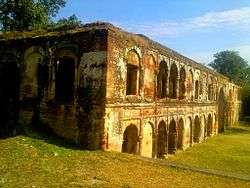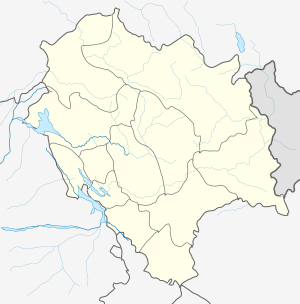Tira Sujanpur
Tira Sujanpur, also known as Sujanpur Tira or Sujanpur Tihra, is a town and municipal council in the Hamirpur district of the Indian state of Himachal Pradesh. The town is located on the bank of the Beas River.
Sujanpur Tira Sujanpur | |
|---|---|
Town | |
 The Fort of Sujanpur Tira | |
 Sujanpur Tira Location in Himachal Pradesh, India  Sujanpur Tira Sujanpur Tira (India) | |
| Coordinates: 31.83°N 76.50°E | |
| Country | |
| State | Himachal Pradesh |
| District | Hamirpur |
| Founded by | Raja Abhay Chand |
| Government | |
| • Type | HIMACHAL PRADESH |
| • Body | municipal council |
| Elevation | 562 m (1,844 ft) |
| Population (2011) | |
| • Total | 7,943 |
| Languages | |
| • Official | Hindi |
| Time zone | UTC+5:30 (IST) |
Climate and geographical location
Sujanpur has an average elevation of 562 metres (1,844 feet).
The climate is varied throughout the year with hot summers and cold winters. The winter is especially severe on the banks of Beas River. The temperature varies from 38 °C in the summer, to almost zero degrees in the winter. In the winter there are often areas of low-lying clouds.
Sujanpur is connected by road to all of the major towns in Himachal Pradesh, as well as the rest of the country. It's neighboring towns include Hamirpur, Palampur, Joginder Nagar, and Dharamshala. There are many bus connections to surrounding towns and cities. The nearest railway station is in Maranda.
About three decades ago, the Sainik School was opened in the town.
Demographics
As of the 2011 Census of India,[1] the Tira Sujanpur Municipal Council has a population of 7,943, of which 4,262 are male, and 3,681 are female. The literacy rate of Tira Sujanpur City is 91.73%, higher than the state average of 82.80%.
Sujanpur is the only city in the Hamirpur region which is open to tourists.
Overview
Sujanpur was previously inhabited by Maharaja Sansar Chand Katoch, the king of Kangra. He constructed his palaces, temples, and courts on top of a hill called Tira, hence the name of the town is Sujanpur Tira. In the middle of the town, there is one square kilometer of green ground, which in the Pahari language is called the 'Chaugan'. Part of this ground is occupied by the Sanik School. The notable Holi fair also takes place on this ground, and lasts for almost three weeks during the month of March.
Based on the caste system, each side of the 'Chaugan' is occupied by Brahmins, Vaishyas, Kashtriyas, and Shudras, but the concept is now waning. The town has two temples constructed by the king, which are Bansiwala (for Lord Krishna) on one side of the ground, and for Narvdeshwar on the other side. One of the temples at Tira was destroyed during the 1905 Kangra earthquake, as were the most of the palace buildings. The Archaeological Department has tried to restore some of the monuments. Some of the Kangra paintings were collected by commissioner E.N. Mangatrai, and some were returned to the museum in Chandigarh.
History of Tira Sujanpur
Sujanpur bears its name from the Hindi word Sajjanpur, which means "the town of honest and gentle people". The name was later changed to Sujanpur Tira when Maharaja Sansar Chand Katoch moved his capital from Kangra to here, and constructed large buildings at the top of the hill ‘Tira’. In 1972 Kangra was merged with the newly founded state of Himachal Pradesh. Later Kangra was split into three districts, separating Sujanpur from Kangra, so Sujanpur became part of the Hamirpur District.
Overlooking the town of Sujanpur, Abhay Chand Katoch—the ruler—built a fortified palace at the top of the hill called Tira in 1748 AD. When Kangra was taken over by Maharaja Ranjit Singh, after Jwalamukhi treaty, with Sansar Chand,Maharaja Sansar Chand Katoch moved his capital to Sujanpur on the left bank of river Beas. Hence the town acquired the name 'Tira' attached to its original name of Sujanpur. This king was respected during his regime, because Sujanpur was flourishing in many aspects. He also created a one square kilometer green ground in the midst of the town (called Chaugan) which was used to train soldiers for war. Part of the ground is now occupied by Sanik School.
The Fort of Sujanpur Tira still belongs to the descendents of Maharaja Sansar Chand.
Adjoining the Kangra Fort is the Maharaja Sansar Chandra Museum run by the Royal Family of Kangra.
Occupations of the people
The major industries in the town are business, agriculture, and services. Many of the young people want to serve in the army.
At present, the total population is close to 10,000 and over 93% of the populace is literate. The population of men to women is almost 50:50. Only 10% of the population is below 6 years old. This town has produced educated people occupying positions at the national and international levels in many professions. Many of these have received national and international recognition. At one time it was the most well-educated town in the old Kangra district, but due to development needs, Kangra was divided into many districts.
Temples of Sujanpur Tira
Maharaja Sansar Chand Katoch built large palaces and temples. Some of the temples are places of great architecture and Kangra paintings. The Murlimanohar (now known as Bansiwala) temple stands on the left side of the ground, and the Narvadeshwar temple dedicated to Shiva-Parvti overlooks the bank of the Beas river. Another temple is Thakardwara, and there are also other smaller temples. The temples were built in 1790 AD and 1823 AD by Maharani Pransani Devi-Suketi Rani of Maharaja Sansar Chand Katoch. Maharaja Sansar Chand also built the Chamunda Devi temple within the premises of the palace, which still exists. The people of Sujanpur are very religious-minded.
Monumental ruins
Palaces, courts and temples built by Maharaja Sansar Chand Katoch still exist in Tira, though some have been destroyed by the passage of time and natural disasters. Baradari (the daily court) still stands and can be seen from the 'Chuagan' ground. He also built a huge water reservoir to take care of the needs of daily water for the town. A lot of work was done by M. S. Randhawa who tried to restore parts of the heritage. He also started collecting Kangra paintings. Many of them are available in the Chandigrah Museum and with the last living king of Lambagraon. Maharaja Sansar Chand died in 1824 in Alampur, just across Sujanpurtira on the opposite side of Beas River.
Devastation by 1905 earthquake
The earthquake of 1905 almost destroyed the entire valley of its architecture, palaces, and temples. 90% of the houses were destroyed.
Festivals
The Holi festival is celebrated, and has become a tradition for 3–4 weeks during the month of March. Other festivals like Diwali, Lohri, Shivratri, Janamashtami Baisakhi, Basant Panchami, and many others are also celebrated by the people in this town.
References
| Wikimedia Commons has media related to Tira Sujanpur. |
- "Tira Sujanpur Population Census 2011". Census Commission of India.